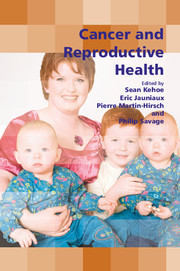Book contents
- Frontmatter
- Contents
- Participants
- Preface
- SECTION 1 Epidemiology, Genetics and Basic Principles of Chemotherapy and Radiotherapy
- SECTION 2 Fertility Issues and Paediatric Cancers
- SECTION 3 Gynaecological Cancers and Precancer
- SECTION 4 Diagnostic Dilemmas
- SECTION 5 The Placenta
- SECTION 6 Non-Gynaecological Cancers
- 18 Pregnancy and breast cancer
- 19 The haematological malignancies
- 20 Melanoma and reproductive health
- SECTION 7 Multidisciplinary Care and Service Provision
- SECTION 8 Consensus Views
- Index
18 - Pregnancy and breast cancer
from SECTION 6 - Non-Gynaecological Cancers
Published online by Cambridge University Press: 05 October 2014
- Frontmatter
- Contents
- Participants
- Preface
- SECTION 1 Epidemiology, Genetics and Basic Principles of Chemotherapy and Radiotherapy
- SECTION 2 Fertility Issues and Paediatric Cancers
- SECTION 3 Gynaecological Cancers and Precancer
- SECTION 4 Diagnostic Dilemmas
- SECTION 5 The Placenta
- SECTION 6 Non-Gynaecological Cancers
- 18 Pregnancy and breast cancer
- 19 The haematological malignancies
- 20 Melanoma and reproductive health
- SECTION 7 Multidisciplinary Care and Service Provision
- SECTION 8 Consensus Views
- Index
Summary
Introduction
Pregnancy and associated factors are known to modify breast cancer risk. In addition, pregnancy-associated breast cancer (PABC) — defined as breast cancer that is diagnosed during a pregnancy or within 1 year postpartum — is a clinically challenging situation for the patients, their families and their physicians.
This review attempts to identify how pregnancy and lactation modify breast cancer risk, highlight what can be regarded as state of the art in the diagnosis and treatment of PABC, and consider the issue of preserving fertility during the treatment of breast cancer.
Pregnancy-associated factors and breast cancer risk
Intrauterine factors and breast cancer risk
It has recently become clear that the stage for carcinogenesis might be set as early as the perinatal period. A systematic search for studies that assessed association between perinatal factors and risk of breast cancer was performed by Michels and Xue. Their findings are summarised in this section.
Birth weight
The majority of the nearly 30 studies on this topic identified a positive link between birth weight and premenopausal, but less commonly postmenopausal, breast cancer. The relative risk (RR) estimate for breast cancer comparing women with high birth weight with women with low birth weight combining all studies was 1.15 (95% CI 1.09—1.21). The mechanisms underlying this association probably include elevated levels of growth factors that may increase the number of susceptible stem cells in the mammary gland or initiate tumours through DNA mutations.
- Type
- Chapter
- Information
- Cancer and Reproductive Health , pp. 229 - 242Publisher: Cambridge University PressPrint publication year: 2008

